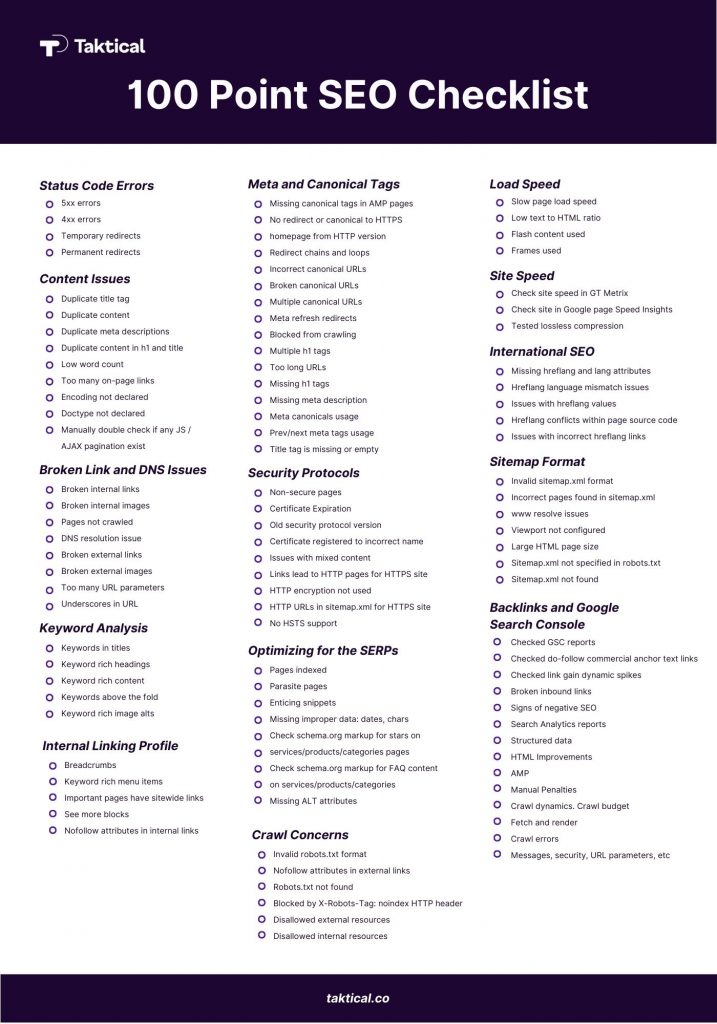The digital world is teeming with competition, making search engine optimization (SEO) essential for maintaining visibility and staying ahead in the game. And getting to the top of search results can make a huge impact on your business – in fact, the number one organic search result in Google has an average CTR over 27%. Moving up even one spot in the results can lead to a CTR increase of 2.8% on average.
It all starts with an SEO strategy that covers all the bases of organic optimization. That’s what an SEO audit checklist is for. We’re sharing our 100-point website content audit checklist that we’ve used to achieve huge success with clients, like growing Artsy’s monthly visitors by 2000% and bringing in over 400 more leads per month to Fueled. Grab the SEO audit checklist below, along with an explanation of each section’s importance.
Onsite Technical SEO
Status Code Errors
Onsite Technical SEO is the cornerstone of any SEO strategy, so it should be the starting point for a website content audit. Improving onsite technical SEO involves addressing HTTP server errors that are indicative of client and server issues, like the classic 404 “Not Found” error and 502 “Bad Gateway”.
- 5xx errors
- 4xx errors
- Temporary redirects
- Permanent redirects
Content issues
Duplicate content is also a significant issue you need to check for. Search engines may struggle to identify which version to index, potentially leading to lowered rankings. Avoid duplication in content, title tags, and meta descriptions.
- Duplicate title tag
- Duplicate content
- Duplicate meta descriptions
- Duplicate content in h1 and title
- Low word count
- Too many on-page links
- Encoding not declared
- Doctype not declared
- Manually double check if any JS / AJAX pagination exist
Broken links and DNS issues
Broken internal links and images impair user experience and make it difficult for search engine crawlers to crawl your site. DNS resolution issues can also harm the website experience and make it inaccessible – you should conduct regular DNS checks to catch these errors before they cause a serious problem.
- Broken internal links
- Broken internal images
- Pages not crawled
- DNS resolution issue
- Broken external links
- Broken external images
- Too many URL parameters
- Underscores in URL
Sitemap format
Site navigation and structure also play an indispensable role in SEO, and should be a part of any website audit template. Search engine bots need access to crawlable pages, and a correctly formatted sitemap.xml is fundamental for guiding them. Large HTML page size is also a factor, and can slow down your website and negatively affect your SEO efforts.
- Invalid sitemap.xml format
- Incorrect pages found in sitemap.xml
- www resolve issues
- Viewport not configured
- Large HTML page size
- Sitemap.xml not specified in robots.txt
- Sitemap.xml not found
Meta and canonical tags
The role of meta tags and canonicalization is hugely important to how search engines interpret your site. Duplicate meta descriptions can lead to confusion, while canonical tags direct search engines to the preferred version of a page when duplicate or similar content exists. Additional issues like multiple h1 tags or excessively long URLs can confuse search engines and users alike.
- Missing canonical tags in AMP pages
- No redirect or canonical to HTTPS homepage from HTTP version
- Redirect chains and loops
- Incorrect canonical URLs
- Broken canonical URLs
- Multiple canonical URLs
- Meta refresh redirects
- Blocked from crawling
- Multiple h1 tags
- Too long URLs
- Missing h1 tags
- Missing meta description
- Meta canonicals usage
- Prev/next meta tags usage
- Title tag is missing or empty
Security protocols
Security and HTTPS implementation belong to our SEO audit checklist because they serve a dual purpose – safeguarding data and contributing to SEO. Search engines favor secure websites, making it vital to monitor HTTPS certificates and resolve any issues promptly. Non-secure pages and mixed content can risk user data and result in penalties from search engines.
- Non-secure pages
- Certificate Expiration
- Old security protocol version
- Certificate registered to incorrect name
- Issues with mixed content
- Links lead to HTTP pages for HTTPS site
- HTTP encryption not used
- HTTP URLs in sitemap.xml for HTTPS site
- No HSTS support
Load speed
Load speed and user experience directly correlate. The quicker your site loads, the better the user experience, which search engines reward. Removing outdated technologies like frames or Flash and maintaining a healthy text-to-HTML ratio can significantly improve your load speed.
- Slow page load speed
- Low text to HTML ratio
- Flash content used
- Frames used
Crawl concerns
Advanced technical SEO considerations for your website content audit revolve around the correct usage of robots.txt and X-Robots-Tag. These features guide crawlers correctly and efficiently so the search engines know which parts of your site they should access – and which are blocked.
- Invalid robots.txt format
- Nofollow attributes in external links
- Robots.txt not found
- Blocked by X-Robots-Tag: noindex HTTP header
- Disallowed external resources
- Disallowed internal resources
International SEO: hreflang
hreflang values, which are essential for multilingual websites, are crucial for international SEO as they help search engines understand the language and geographical targeting of a webpage – this enhances the user experience by serving the most appropriate version of the content. Without accurate hreflang implementation, you risk having website content displayed to the wrong audience, leading to increased bounce rates, lower engagement, and potential revenue loss.
- Missing hreflang and lang attributes
- Hreflang language mismatch issues
- Issues with hreflang values
- Hreflang conflicts within page source code
- Issues with incorrect hreflang links
Site Speed
Site speed has become a particularly critical ranking factor in SEO ever since Google’s update to page experience in 2021. It makes sense: speed impacts the user experience, and Google’s algorithm is always updating to provide results that best serve its users. A website audit tool geared towards site speed like GT Metrix and Google Page Speed Insights provides a detailed look at performance, and techniques like lossless compression can dramatically improve site speed.
- Check site speed in GT Metrix
- Check site in Google page Speed Insights
- Tested lossless compression
To further enhance performance beyond standard techniques, it’s also worth considering improvements to the site’s front-end architecture. Implementing Hyvä theme development services can help streamline resource usage and reduce unnecessary code overhead – leading to faster load times, improved responsiveness, and a more scalable front-end framework across a wide range of platforms.
Backlinks and Google Search Console
A robust backlink profile increases your site’s authority. Regular checks using Google Search Console (GSC) reports can help maintain a healthy profile and identify other potential issues, including broken inbound links, structured data status, HTML improvements, and crawl error information. All of these features make it easier to keep your SEO strategy on track.
- Checked GSC reports
- Checked do-follow commercial anchor text links.
- Checked link gain dynamic spikes
- Broken inbound links
- Signs of negative SEO
- Search Analytics reports
- Structured data
- HTML Improvements
- AMP
- Manual Penalties
- Crawl dynamics. Crawl budget
- Fetch and render
- Crawl errors
- Everything else: Messages, security, URL parameters, etc
Optimizing for the SERPs
In Search Engine Results Pages (SERPs), correct indexing is crucial for visibility. There are also other SEO audit checklist items to tick off here, like identifying and handling parasite pages that might siphon your site’s authority. And add enticing snippets, which appear as rich snippets in the SERPs and can increase click-through rates – improving your site’s perceived relevance and boosting site rankings.
- Pages indexed
- Parasite pages
- Enticing snippets
- Missing improper data: dates, chars
- Check schema.org markup for stars on services/products/categories pages
- Check schema.org markup for FAQ content on services/products/categories
- Missing ALT attributes
Keyword analysis
Keywords are at the heart of SEO. They’re the words and phrases users are typing into search engines, and it’s here at the top of these relevant searches that you want your business to appear. Since they’re the basis for how people organically searching will find your content, they’re a key part of a website content audit. Placing keywords in titles, headings, content – especially above the fold – and in image alt tags can dramatically improve SEO performance.
- Keywords in titles
- Keyword rich headings
- Keyword rich content
- Keywords above the fold
- Keyword rich image alts
Internal linking profile
Internal links, like breadcrumbs and sitewide links to important pages, help guide users and search engine crawlers. This improves the user experience – and therefore also SEO.
- Breadcrumbs
- Keyword rich menu items
- Important pages have sitewide links
- See more blocks
- Nofollow attributes in internal links
- URL structure
Follow the SEO audit checklist for success
Succeeding at SEO involves a broad array of components, each contributing to the overall performance and visibility of your site. Regular SEO checks and maintenance are essential for ensuring continued visibility and adaptability in the ever-evolving digital landscape. Following our website audit template is a great start for getting organized and continuing to regularly review your site’s SEO performance. And for further assistance with this checklist – or if you want a partner who can handle the whole process for you – get in touch with us, and we’ll let you know how we can help.
Download this full SEO audit checklist infographic as an HTML script to embed in your own site here:









